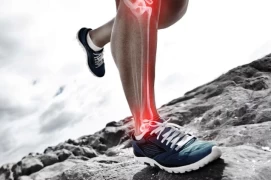
Shoulder Arthroscopy
- Shoulder Arthroscopy
- What is Shoulder Arthroscopy?
- What are the Stages of Shoulder Arthroscopy Application?
- In Which Diseases Is Shoulder Arthroscopy Used?
- Is Shoulder Arthroscopy Application Dangerous?
- What is the Recovery Process After Shoulder Arthroscopy Application?
What is Shoulder Arthroscopy?
Shoulder arthroscopy is a surgical procedure used to view and treat the inside of the shoulder joint. This procedure is used to better understand, diagnose and treat problems that occur in the shoulder.
During shoulder arthroscopy, a small camera and surgical instruments are placed inside the shoulder joint. The camera provides images of the inside of the shoulder displayed on the screen, and the surgeon uses his instruments to repair problems occurring in the shoulder.
Shoulder arthroscopy can be used in a number of conditions that cause pain, stiffness, or limitation of motion in the shoulder. These conditions include rotator cuff injuries, recurrent shoulder dislocations, osteoarthritis, tendonitis, and cartilage injuries.
Shoulder arthroscopy is usually performed under local anesthesia and has a procedure time of several hours. After the procedure, patients are discharged the same day and can usually return to their normal activities within a few weeks. The healing process may vary depending on the patient's condition and the problem being treated.
What are the Stages of Shoulder Arthroscopy Application?
Shoulder arthroscopy application usually includes the following stages:
- Anesthesia: Local anesthesia is usually given before the procedure begins. This means that only the shoulder area is numbed and allows the patient to relax appropriately.
- Intervention: The surgeon makes a small incision in the shoulder area and makes several small punctures containing an arthroscopic camera and surgical instruments. The camera provides images that show the structures inside the shoulder joint.
- Examination: The surgeon determines the location and severity of the problem by examining the inside of the shoulder joint with an arthroscopic camera. At this stage, damage or problems in the shoulder joint can be detected, such as cartilage injuries or tendonitis.
- Treatment: The surgeon uses surgical instruments to repair the problem in the shoulder joint. At this stage, damaged tissue can be repaired, cartilage injuries can be treated, or other problems in the shoulder joint can be resolved.
- Completion: When the surgeon completes the procedure, the arthroscopic instruments and camera are removed and the incisions are sutured.
- Recovery: It may take several weeks for the patient's shoulder to heal. Doctors often recommend that patients begin physical therapy. Physical therapy helps restore the range of motion and strength of the shoulder joint.
In Which Diseases Is Shoulder Arthroscopy Used?
Shoulder arthroscopy can be used to treat the following diseases:
- Rotator cuff tears: The rotator cuff is a group of muscles and tendons surrounding the shoulder joint. In the event of injury or damage, rotator cuff tears can occur. Shoulder arthroscopy can be used to repair rotator cuff tears.
- Shoulder dislocations: Shoulder dislocations are where the shoulder joint comes out. Recurrent shoulder dislocations can be repaired with arthroscopy.
- Calcification: When calcification occurs in the shoulder joint, the cartilage inside the joint may deteriorate and cause pain. Shoulder arthroscopy can be used for treatments such as repairing or replacing cartilage surfaces.
- Tendonitis: The tendons in the shoulder attach to the muscles required for shoulder movements. Tendonitis can occur due to inflammation or tear in these tendons. Shoulder arthroscopy can be used to repair or surgically treat tendons.
- Labrum injuries: The labrum is a ring surrounding the shoulder joint. In case of damage or rupture, injuries to the labrum can occur. Shoulder arthroscopy can be used to repair labrum injuries.
Shoulder arthroscopy can also be used to treat other problems in the shoulder. However, it is important to consult with the doctor to determine the appropriate course of treatment in each case.
Is Shoulder Arthroscopy Application Dangerous?
Like any surgical procedure, shoulder arthroscopy can carry some risks. However, these risks are generally low and are further reduced if performed by an experienced surgeon performing the procedure. Some possible risks may include:
- Infection: As with any surgical procedure, there is a risk of infection. Therefore, it should be done in a sterile environment and taking appropriate precautions to prevent infection.
- Bleeding: During shoulder arthroscopy, there is a risk of bleeding. However, bleeding is usually minimal and treatable.
- Anesthesia complications: Although rare, anesthesia carries some risks. However, the risks are minimal if carefully managed by the anesthesiologist.
- Restriction of shoulder movements: After shoulder arthroscopy, shoulder movements may be restricted for several days. However, with the help of physical therapy and rehabilitation, movements can return to normal.
- Damage to the shoulder joint: In rare cases, surgical instruments can cause damage to the shoulder joint. However, this type of damage is also usually treatable.
Like any surgical procedure, shoulder arthroscopy carries risks. However, in order to minimize the risks, it is important to carefully follow the pre- and post-procedure instructions with an experienced surgeon who will perform the procedure.
What is the Recovery Process After Shoulder Arthroscopy Application?
The recovery process after shoulder arthroscopy may vary depending on the person's age, general health status, the type of procedure performed and how complex the procedure is. However, it usually consists of the following stages:
- Immediately After: In the first few hours after surgery, the patient is usually awakened and kept under observation in the hospital for a short time. Medications may be prescribed for pain control.
- First Week: During the first week, the patient should take prescription medications for pain control and rest the shoulder. Physical therapy and rehabilitation may be recommended.
- First Month: During the first month, the patient can use his/her shoulder in daily living activities while continuing the physical therapy and rehabilitation program. However, it is important to avoid heavy lifting and strenuous exercise.
- First 3 Months: During the first 3 months, the patient can exercise to strengthen the shoulder gradually. However, it is still important to avoid heavy lifting and strenuous activities.
- 6-12 Months: For 6-12 months, the patient should continue the physical therapy and rehabilitation program to fully strengthen the shoulder. During this time, it may be possible for the patient to return to normal activities and even play sports.
The recovery process may vary according to the general health status of the patient, age and type of the procedure. However, in order to speed up the patient's recovery process, it is important to follow the doctor's recommendations and regularly participate in the physical therapy program. Also, avoiding heavy lifting and strenuous activities can help gradually strengthen the shoulder and allow for full recovery.



